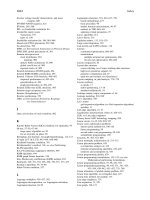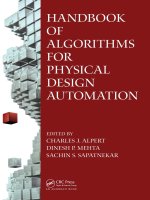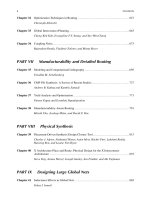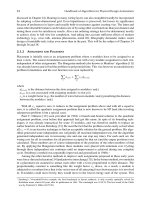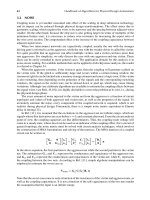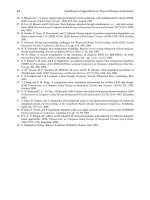- Trang chủ >>
- Khoa Học Tự Nhiên >>
- Vật lý
Handbook of algorithms for physical design automation part 64 docx
Bạn đang xem bản rút gọn của tài liệu. Xem và tải ngay bản đầy đủ của tài liệu tại đây (248.66 KB, 10 trang )
Alpert/Handbook of Algorithms for Physical Design Automation AU7242_C030 Finals Page 612 19-9-2008 #15
612 Handbook of Algorithms for Physical Design Automation
In gen eral, the accuracy of p lacement-based metrics decreases as the level of abstraction of the netlist
increases. Indeed, almost all the metrics proposed for u se during logic synthesis to date are graph
theoretic in nature. With the problem of routing congestion g ettin g worse because of the scaling
of design sizes and process technologies, a comprehensive congestion management strategy must
target congestion through the entire design flow, relying o n the appropriate congestion estimators at
each stage.
The interested reader can find further details on all the metrics discussed in this chap ter in the
corresponding papers, or in Ref. [SSS07].
REFERENCES
[CZY+99] Chen, H. -M., Zhou, H., Young, F. Y., Wong, D. F., Yang, H. H., and Sherwani, N., Inte-
grated floorplanning and interconnect planning, Proceedings of the International Conference on
Computer-Aided Design, San Jose, CA, pp. 354–357, 1999.
[Che94] Cheng, C. -L. E., R
ISA: Accurate and efficient placement routability modeling, Proceedings of the
International Conference on Computer-Aided Design, San Jose, CA, pp. 690–695, 1994.
[CL00] Cong J. and Lim, S., Edge separability based circuit clustering with application to circuit partition-
ing, Proceedings of the Asia and South Pacific Design Automation Conference, Yokohama, Japan,
pp. 429–434, 2000.
[Dai01] Dai, W., Hierarchial physical design methodology for multi-million gate chips, Proceedings of the
International Symposium on Physical Design, Sonoma, CA, pp. 179–181, 2001.
[HNR68] Hart, P.E., Nilsson,N.J., andRaphael, B.,Aformal basisfortheheuristic determination ofminimum
cost paths, IEEE Transactions on System Science and Cybernetics SSC-4, pp. 100–107, 1968.
[HB97] Hauck, S. and Borriello, G., An evaluation of bipartitioning techniques, IEEE Tr ansactions
on Computer-Aided Design of Integrated Circuits and Systems 16(8): 849–866, August 1997.
(ARVLSI 1995).
[Hig69] Hightower, D. W., A solution to line routing problems on the continuous plane, P roceedings of the
Design Automation Workshop, NY, pp. 1–24, 1969.
[HM02] Hu, B. and Marek-Sadowska, M., Congestion m inimization during placement without estimation,
Pr oceedings of the International Conference on Computer-Aided Design, San Jose, CA, pp. 739–
745, 2002.
[KR05] Kahng, A. B. and Reda, S., Intrinsic shortest path length: A new, accurate a priori wirelength
estimator, Proceedings of the International Conference on Computer-Aided Design, San Jose, CA,
pp. 173–180, 2005.
[KX03] Kahng, A. B. and Xu, X., Accurate pseudo-constructive wirelength and congestion estimation,
Pr oceedings of the International Workshop on System-Level Interconnect Prediction, Monterey,
CA, pp. 61–68, 2003.
[KK03] Kravets, V. and Kudva, P., Understanding metrics in logic synthesis for routability enhancement,
Pr oceedings of the International Workshop on System-Level Interconnect Prediction, Monterey,
CA, pp. 3–5, 2003.
[KSD03] Kudva, P., Sullivan, A., and Dougherty, W., Measurements for structural logic s ynthesis optimiza-
tions, IEEE Transactions on Computer-Aided Design of Integrated Circuits and Systems 22(6):
665–674, June 2003. (ICCAD 2002).
[LR71] Landman, B. S. and Russo, R. L., On a pin versus block relationship for partitions of logic graphs,
IEEE Transactions on Computers C -20(12): 1469–1479, December 1971.
[LAQ+07] Li, Z., Alpert, C. J., Quay, S. T., Sapatnekar, S., and Shi, W., Probabilistic congestion prediction
with partial blockages, Proceedings of the International Symposium on Quality Electronic Design,
San Jose, CA, pp. 841–846, 2007.
[LJC03] Lin, J., Jagannathan, A., and Cong, J., Placement-driven t echnology mapping for LUT-based
FPGAs, Proceedings of the International Symposium on Field Programmable Gate Arrays,
Monterey, C A, pp. 121–126, 2003.
[LM05] Liu, Q. and Marek-Sadowska, M., Wire length prediction-based technology mapping and fanout
optimization, Proceedings of the International Symposium on Physical Design, San Francisco, CA,
pp. 145–151, 2005.
Alpert/Handbook of Algorithms for Physical Design Automation AU7242_C030 Finals Page 613 19-9-2008 #16
Estimation of Routing Congestion 613
[LTK+02] Lou, J., Thakur, S., Krishnamoorthy, S., and Sheng, H . S., Estimating routing congestion u sing
probabilistic analysis, IEEE Transactions on Computer-Aided Design of Integrated Circuits and
Systems 21(1): pp. 32–41, January 2002. (ISPD 2001).
[PC06] Pan, M. and Chu, C., FastRoute: A step to integrate global routing i nto placement, Proceedings of
the International Conference on Computer-Aided Design, San Jose, CA, pp. 464–471, 2006.
[PPS03] Pandini, D., Pileggi, L. T., and Strojwas, A. J., Global and local congestion optimization in
technology mapping, IEEE Transactions on Computer-Aided Design of Integrated Cir cuits and
Systems 22(4): 498–505, April 2003. (ISPD 2002).
[PP89] Pedram, M. and Preas, B., Interconnection length estimation for optimized standard cell lay-
outs, Proceedings of the International Conference on Computer-Aided Design, Santa Clara, CA,
pp. 390–393, 1989.
[SSS07] Saxena, P., Shelar, R. S., and Sapatnekar, S. S., Routing Congestion in VLSI Circuits: Estimation
and Optimization, New Yor k: Springer, 2007.
[SPK03] Selvakkumaran, N., Parakh, P. N., and Karypis, G., Perimeter-degree: A priori metric for directly
measuring and homogenizing interconnection complexity in multi-level placement, Proceedings
of t he International Workshop on Syst em-level Interconnect Prediction, Monterey, CA, pp. 53–59,
2003.
[SY05] Sham, C. and Young, E. F. Y., Congestion prediction in early stages, Proceedings of the Interna-
tional Workshop on Syst em-level Interconnect Prediction, San Francisco, CA, pp. 91–98, 2005.
[SSS+05] Shelar, R., Sapatnekar, S., Saxena, P., and Wang, X., A predictive distributed congestion metric
with application to technology mapping, IEEE T ransactions on Computer-Aided Design of
Inte grated Circuits and Systems 24(5): 696–710, May 2005. (ISPD 2004) .
[SSS06] Shelar, R., Saxena, P., and Sapatnekar, S., Technology mapping algorithm targeting routing
congestion under delay constraints, IEEE Transactions on Computer-Aided Design of Integrated
Circuits and Systems 25(4): 625–636, April 2006. (ISPD 2005) .
[SK93] Shin, H. and Kim, C., A simple yet effective technique for partitioning, IEEE Transactions on Very
Large Scale Integration Systems 1(3): 380–386, September 1993.
[SK01] Stok, L. and Kutzschebauch, T., Congestion aware layout driven logic synthesis, Proceedings of
the International Conference on Computer-Aided Design, San Jose, CA, pp. 216–223, 2001.
[VP95] Vaishnav, H. and Pedram, M., Minimizing the r outing cost during l ogic extraction, Proceedings of
the Design Automation Conference, San Francisco, CA, pp. 70–75, 1995.
[WBG04] Westra, J., Bartels, C., and Groeneveld, P., Probabilistic congestion prediction, Pr oceedings of the
International Symposium on Physical Design, Phoenix, AZ, pp. 204–209, 2004.
[WBG05] Westra, J., Bartels, C., and Groeneveld, P., Is probabilistic congestion estimation worthwhile?,
Pr oceedings ofthe International Workshop on System-Level Interconnect Prediction, San Francisco,
CA, pp. 99–106, 2005.
Alpert/Handbook of Algorithms for Physical Design Automation AU7242_C030 Finals Page 614 19-9-2008 #17
Alpert/Handbook of Algorithms for Physical Design Automation AU7242_C031 Finals Page 615 29-9-2008 #2
31
Rip-Up and Reroute
Jeffrey S. Salowe
CONTENTS
31.1 Overview 615
31.1.1 Definition 615
31.2 RoutingFormulation 616
31.2.1 Lagrangian Relaxation 616
31.2.2 Steiner TreeConstruction 617
31.2.3 A
∗
Maze Search 617
31.2.4 Cost Functions and Constraints 618
31.3 Rip-Up-and-Reroute Schemas 618
31.3.1 Progressive Rerouting Schema 619
31.3.1.1 Issues 620
31.3.2 Iterative ImprovementSchema 621
31.3.2.1 Issues 622
31.4 Rip-Up-and-Reroute Strategies 624
31.5 History 624
31.6 Engineering Practicality 625
References 625
31.1 OVERVIEW
In this chapter, we explain some of the intricacies of rip-up and reroute by focusing on one common
routing formulation. With respect to this routing formulation, we examine two rip-up-and-reroute
schemas, which are basic techniques. After examining the schemas and assessing their strengths
and weaknesses, we show how strategies that combine the different schemas can be constructed.
The strategies attempt to counter the weaknesses of the schemas themselves. These concepts are
illustrated with so me o f the seminal papers in the field. Rip-up and reroute has been successfully
applied during all phases of routing, including global routing, detailed routing, track assignment,
and layer assignment.
31.1.1 DEFINITION
Rip-up and reroute is an iterative technique whose basic step is to remove one or more connections
and replacethem with newconnections.This idea can beapplied in manyways. For instance,suppose
as depicted in Figure 31.1a that connection r1 has been added, but connection r2 cannot be added
without a violation because connection r1 uses a resource that r2 needs. One can remove all or part
of r1, add connection r2, and then make a new connection for r1 as depicted in Figure 31.1b through
d, respectively. Another possibility is to shift connection r1 away from the critical resource, and
then to add r2. Yet another possibility is to place a tax, or congestion cost, on the common resource,
hoping that connection r1 or connection r2 will avoid the taxed region.
615
Alpert/Handbook of Algorithms for Physical Design Automation AU7242_C031 Finals Page 616 29-9-2008 #3
616 Handbook of Algorithms for Physical Design Automation
(a) (b)
(d)(c)
A
A
r1
r1
A
r1
r 2
r 2
A
r1
FIGURE 31.1 (a) Wire r1 blocks pin access to A. A is on metal 1, A is surrounded by blockages (not depicted),
and r1 i s on metal 2. (b ) A portion of wire r1 is removed to allow access to A. (c) Wire r2 on metal 3 can access
pin A using a vi a stack from metal 3 to metal 1. (d) Wire r1 is rerouted on metal 2.
31.2 ROUTING FORMULATION
To illustrate rip-up and reroute, we simplify the routing p roblem using Lagrangian relaxa tion, ulti-
mately transforming the problem into successive shortest-path problems. This basic framework was
outlined by Linsker (1984). Once the basic framework is established, we examine different rerouting
strategies, pointing out their strengths and weaknesses.
31.2.1 LAGRANGIAN RELAXATION
A routing problem is an optimization problem of the form
minimize f (X)
subject to g
i
(X) ≤ 0, 1 ≤ i ≤ n
We separate the constraints into two classes, network constraints n
i
(X) ≤ 0, 1 ≤ i ≤ N, and design
constraints d
i
(X) ≤ 0, 1 ≤ i ≤ D.
minimize f (X)
subject to n
i
(X) ≤ 0, 1 ≤ i ≤ N
d
i
(X) ≤ 0, 1 ≤ i ≤ D
Networkconstraintsstatethat the network topologymust satisfy certainrequirements, such as thenet-
workmust connectallthe pins without formingloops.Exceptforspecial nets, thenetwork constraints
state that a Steiner tree implements each net. Design constraints state that the network is designed
in a legal way, such as no two routes occupy the same spot, o r no two shapes are too close together.
The global routing design constraints state that no area contains too many routing shapes. If an
area contains too many global routing shapes, it may not be possible to detail route the area without
violating the detail routing design constraints.
Alpert/Handbook of Algorithms for Physical Design Automation AU7242_C031 Finals Page 617 29-9-2008 #4
Rip-Up and Reroute 617
A routing problem is feasible if there is any solution that satisfies the constraints. For any
interesting routing problem, it is NP-hard to determine if there is a feasible solution.
Chip designers, however, are not interested in abstract complexity issues: they typically try to
make chips that have feasible routing (based on earlier experience) and then adjust the constraints to
achieve their objectives. The typical input is therefore likely to have a feasible solution. Furthermore,
some design constraints are soft, such as those given to a global router. It may be possible to
overcongest a few areas and still solve the resulting detailed routing problem. This means that
even if the result is infeasible for the original problem, it may still be useful.
A general and powerful technique to solve hard optimizations problems is to apply Lagrangian
relaxation (Ahuja et al. 1993). In Lagrangian relaxation, one or more constraints are added to the
objective fu nction using Lag rangian multipliers λ
i
. Under appropriate conditions, Lagrangian relax-
ation can be used to solve optimization problems exactly; conditions for convergenceare discussed in
Ahuja et al. (1993). In other cases, however, Lagrangian relaxation is used to simplify complicating
constraints. Routing falls into the second category: one applies Lagrangian multipliers to the d esign
constraints, resulting in an optimization problem:
minimize f (X) + λ
∗
i
d
i
(X)
subject to n
i
(X) ≤ 0
λ
i
≥ 0
In the Lagrangian relaxation of a routing problem, only the network constraints need to be satisfied.
This means that any set of Steiner trees is a feasible solution, which is a considerable simplification.
The design constraints are “taxed” by the Lagrangian multiplier. The penalty for violating a desig n
constraint is proportional to the Lagrangian tax.
Global routing problems have some soft constraints, so the Lagrangian relaxation technique is
natural. Detailed routing problems can be phrased in exactly the same way, but the Lagrangian taxes
are high because a violated design constraint may cause a chip to fail. Sometimes, though, there are
soft constraints in detailed routing, where a violation is unwelcome but not prohibited. An example
is a wide spacing rule to minimize cross talk that can be violated in a congested region.
31.2.2 STEINER TREE CONSTRUCTION
A Steiner minimal tree is a shortest connection of a set of points. Finding a Steiner minimal tree in
the plane or in a graph is NP-hard, even if there are no obstructions. To make matters even more
complicated, there are usually several routing layers, routing obstructions, and congestion.
Lagrangian relaxation simplifies the routing problem into simultaneous Steiner tree construction
of a set of nets. Although the Steiner tree problem is itself hard, one may not need the absolutely
shortest tree, and there are special cases that are solvable in polynomial time. For instance, a Steiner
minimal treeforatwo-pin net is ashortest-pathproblem, whichcanbefound efficiently. Furthermore,
a properly embedded minimum spanning tree is an excellent heuristic for a Steiner minimal tree
(Hwang et al. 1992). The basic step in Prim’s minimum spanning tree is to find a vertex that is
closest to the tree. It is therefore reasonable to assume that the shortest-path pro blem is an important
component in a routing problem.
31.2.3 A
∗
MAZE SEARCH
The Lee–Moore algorithm is described in Section 23.5. There are one or more sources and one or
more targets; initially, the weight of a source is zero and the weight of a target is infinite. Vertices
are considered in order of weight from the source; when a vertex u is visited, the graph edges (u, v)
incident to u are examined to see if they improve the smallest weight to v. The search stops when a
target is to be considered.
One can decrease the number of vertices visited in the search if one has a conservative estimate
of the distance from each node to the targets. This value, the lower bound, reflects how close each
Alpert/Handbook of Algorithms for Physical Design Automation AU7242_C031 Finals Page 618 29-9-2008 #5
618 Handbook of Algorithms for Physical Design Automation
(a) (b)
FIGURE 31.2 (a) Blockages on a routing grid graph and (b) pr uned routing grid graph.
vertex is to a target. In the A
∗
technique, invented by Nilsson (Hart et al. 1968), the weight of the
path to u plus the estimated distance to a closest target form a new measure, the estimated weight of
a shortest path using the vertex u. Instead of considering vertices in order of weight from the source,
A
∗
considers them in order of estimated shortest-path weight.
The A
∗
technique can speed up the path search enormously if the estimated path length is close
to the actual path length. Unfortunately, A
∗
becomes less effective when the lower bound is overly
conservative. Thishappenswhenobstructionsarenotaccountedfor inthelowerbound,andit happens
when congestion is present but not reflected in the lower bound. Nevertheless, A
∗
has proven to be
of great practical use. In our formulation, the general routing problem is transformed into a set of
path problems in a weighted graph that are solved using A
∗
maze search.
31.2.4 COST FUNCTIONS AND C ONSTRAINTS
Using Lagrangian relaxation, the routing problem becomes a problem of finding shortest paths in
a weighted graph because the Lagrangian taxes are a cost function on the vertices and edges. An
alternative to a very high cost function on a vertex or edge is to remove that vertex or edge from the
graph. For instance, spacing rules in a gridded detailed routing p roblem can be handled by removing
grid points that are in violation with existing objects. This places a constraint on the graph, and it
ensures that the vertex or edge is not used; it may speed up a graph search because the expensive
edges or vertices need not be visited. (Figure 31.2) The main factor in deciding how to represent
the constraint is the complexity of the resulting subproblem. If one uses A
∗
in a weighted graph, the
removal of a graph vertex or edge does not substantially alter the strategy, though it may affect the
running time.
It is also possible to further constrain the path; for instance, one can prune paths that do not
satisfy certain criteria, such as the number of bends in the path (this is done, for instance, in Shin
and Sangiovanni-Vincentelli [1987]). Note that some pruning options are not compatible with an
A
∗
search.
31.3 RIP-UP-AND-REROUTE SCHEMAS
Now that the general formulation is in place, we can examine different rip-up-and-reroute schemas.
A schema reflects a basic methodology, though the actual implementation details may differ from
one author to another. Schemas can be separated based on
1. Identification of rip-up-and-reroute subproblems
2. Selection of routes that are removed when a subproblem is considered
3. Method used to solve these subproblems
Alpert/Handbook of Algorithms for Physical Design Automation AU7242_C031 Finals Page 619 29-9-2008 #6
Rip-Up and Reroute 619
We describe two important schemas, the progressivererouting schema and the iterative improvement
schema. They appear in two key papers in the field, and their concepts have interesting parallels in
network optimization. They form a foundation for powerful routing strategies.
31.3.1 PROGRESSIVE REROUTING SCHEMA
An important rip-up-and-re routeschema can be illustrated with the global routing algo rithm invented
by R. Nair (1987). In Nair’s schema, each net forms a subproblem, and only that net is removed
when the subproblem is considered.
1. For pass = 1to
k
2. For each net
n
3. For each connection
r
in
n
a. Remove
r
b. Reroute
r
Nair tessellated the chip using vertical an d ho rizontal lines in to a two-dimen sional “gcell grid” as
described in Section 23.2.2. A gcell is defined as a smallest rectangle formed by the horizontal and
vertical lines. Nair’s routing graph is the dual of the grid graph: each gcell is a vertex, and an edge
is present between each pair of adjacent gcells.
Nair placed a constraint on each line segment in the grid graph that reflected the number of
wires that could cross that line segment. These represent the design constraints in that area. Using
Lagrangian relaxation, the constraints became costs on the routing graph edges.
Two-pin nets are routed using an A
∗
search. Multipin nets are routed by successive A
∗
searches,
where the source consists of all gcells that intersect the partially constructed net, and the targets are
all pins that are not yet connected in the net.
Nair’s key contribution was the overall routing strategy. In the first pass, each net is routed
subject to the congestion costs incurred from the nets already visited. In each subsequent pass, a net
is removed and completely rerouted. Note that after the first pass, each net will see the congestion
from all the other nets.
Nair justified his method, progressive rerouting, with the intuition that the second pass is better
informed about congestion than the first pass because the second pass sees all the congestion, while
the first pass only sees what was routed so far. He discovered that the overall solution cost generated
by the rerouting process converged to equilibrium after several pa sses; in his case, he stated that
fewer than five passes sufficed.
Although it was not suggested in Nair’s paper, his algorithm can be understood in the context
of noncooperative games. In a noncooperative game, each “agent” acts selfishly on its own behalf,
without regard to the effect on the other agents. An important notion in the theory of noncooperative
games is the concept of a Nash equilibriu m. In a Nash eq uilibrium, no agent can change its behavior
to improve its own state. In time, noncooperative games convergeto a Nash equilibrium.It is known,
however, that a Nash equilibrium may not be a global optimum.
Progressive routing can be seen to be a noncooperative game among the different nets. Each net
is routed in a greedy fashion to minimize its own latency. Progressive rerouting bears a remarkable
similarity to the problem of making traffic assignments. Recent results in traffic assignment theory
shed some light on the efficacy of Nair’s technique. The ratio of the cost of a Nash equilibrium to
the overall minimum cost is called the price of anarchy. Roughgarden and Tardos (2002) showed
that for single commodity flows where the latency function is a linear function of the congestion,
any Nash equilibrium has latency at most 4/3 times the minimum possible total latency. Global
routing, on the other hand, is a multicommodity flow where the commodity cannot be split; for
general multicommodity flows, the price of anarchy can be exponential in the polynomial degree of
the latency function (Lin et al. 2005).
Alpert/Handbook of Algorithms for Physical Design Automation AU7242_C031 Finals Page 620 29-9-2008 #7
620 Handbook of Algorithms for Physical Design Automation
It is not clear that these negative results are immediately applicable to global routing. Global
routing problems are often well behaved; designers are interested in making chips, not confounding
routers. Perhaps one can show a positive result on the price of anarchy of a well-behaved global
routing problem.
Nair’s algorithm also has an interesting parallel to the multicommodity flow approximation tech-
nique described in Chapter 32 (Albrecht 2001). The multicommodity flow approximation technique
proceeds in a series of passes. In each pass, a Steiner minimal tree is found for each net with respect
to a weighted graph. The graph weights are successively modified due to the placement of the trees.
At the end, a rounding technique is used to select the actual implementation of the net. This can
be seen as identical to the structure of Nair’s algorithm; the main difference is in the choice of the
graph weights and in the selection of the Steiner tree implementation. In Nair’s approach, there is
exactly one Steiner tree representation. Steiner trees from prior passes are forgotten, except by how
they affect the graph weights.
31.3.1.1 Issues
The strength of progressive rerouting is simplicity of design. The basic component is A
∗
search; it is
repeated over several passes. The schema converges r a pidly to a reasonable equilibrium state (Nair
1987). However, it has several weaknesses, some of which are given below.
31.3.1.1.1 Detouring
The key problem with successive rerouting is detouring. This is where the length of the routed
connection is much longer than the length of a connection if congestion is not considered. The price
of anarchy refers to the total path length; a single connection, however, can have an arbitrarily long
detour. This is particularly undesirable when timing issues are considered. A net with a weak driver
cannot be detoured, so nets on timing-critical paths must be carefully constructed.
31.3.1.1.2 Initialization
A second issue is establishing a good starting point. At the time of the first pass, no nets are routed,
so these initial nets receive preferential treatment. The nets routed at the end of the first pass will
see the congestion of the preceding nets, and they may detour unnecessarily as a result. Hadsell and
Madden (2003) suggest that this initial routing phase can be seeded with a congestion estimation.
The congestion estimation affects the cost function by applying a tax to high-demand areas.
31.3.1.1.3 Net Ordering
Refer to Figure 31.3. Assume that two wires each need to pass through one of two bottlenecks. Wire
a is wide, and wire b is narrow; gap A can accommodate either wire a and wire b but not both, but
gap B can only accommodate wire b.Ifwireb is assigned to gap A, it has no incentive to relinquish
its position unless wire a is also assigned to gap A. If the cost of putting wire a in gap A is less than
the cost of putting wire a in gap B,wireb prevents an optimal assignment of wires to gaps.
This issue is typically dealt with using net ordering. If the connection containing wire a is
routed first, wire a will be placed in gap A r ather than gap B because it does not fit in gap B.The
connection containing wire b will then be assigned to gap B. Net ordering is an imperfect attempt to
add centralized control to the progressive rerouting process. The task of assigning wires to bottleneck
gaps is a packing problem; such a problem is NP-complete, and heuristics with good performance
can be sophisticated.
31.3.1.1.4 Determining Good Lagrangian Multipliers
Though there are some general techniques to find Lagrangian multipliers (Ahuja et al. 1993), ad hoc
techniques are often used in practice. Users want fast convergence and few detours. Also note that A
∗
performs better when lower bounds and upper bounds match, so the use of a Lagrangian multiplier
when the design is uncongested may slow down the algorithm, even if it is the theoretically correct
Alpert/Handbook of Algorithms for Physical Design Automation AU7242_C031 Finals Page 621 29-9-2008 #8
Rip-Up and Reroute 621
(a) (b)
(c)
A
A
B
B
AB
FIGURE 31.3 (a) Bottleneck gaps A and B.Thinwireb can fit through either. Thick wire a can only fit
through gap A. (b) If wire b is routed first, it may take gap A or gap B.Ifthinwireb takes a resource A that thick
wire a needs, a cannot fit t hrough. (c) If w ire a is routed first, it takes gap A.Wireb can make it through gap b.
thing to do. Several autho rs have investigated this issue. Note that th e multipliers may be affected
by how congestion is modeled and by the routing objectives.
31.3.1.1.5 Divergence
Worse than detouring is divergence, where the designmaybe so congested that almost all connections
detour. In each successive pass, rerouted connections detour even more to avoid congestion, thereby
increasing wirelength dramatically and inducing more congestion. Although successive rerouting
will converge to a Nash equilibrium, there is neither a statement that it must converge in a small
number of passes (it divergesduring these passes) nor is there a bound on the totalwirelengthincrease
per pass. Divergence commonly happens when a design is infeasible.
31.3.2 ITERATIVE IMPROVEMENT SCHEMA
This is the second major schema illustrated. Suppose we have a routing solution that satisfies the
network constraints but not the design constraints. Suppose we select one violated design constraint
and then attempt to resolve it by rip-up and reroute. If no additional design constraints are violated,
the resulting routing solution is deemed to be sup erior to the original one and therefore closer to the
